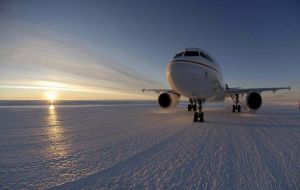MercoPress. South Atlantic News Agency
Antarctic Airbus returns from first flight
 The flight marks the beginning of the new passenger air link between Australia and the Antarctic (Photo: AAD)
The flight marks the beginning of the new passenger air link between Australia and the Antarctic (Photo: AAD) Federal Environment Minister Peter Garrett has arrived in Antarctica on the historic first passenger flight linking the white continent with Australia.
Mr Garrett was among 19 passengers on the 3400km trip from Hobart to the newly built Wilkins runway which will revolutionise Australia's scientific research capabilities in Antarctica. Carved out of 500m thick blue ice, the four-kilometre long Wilkins runway opens up simpler access to Australia's Antarctic research stations. "It will revolutionise the way we can do our research," said Australian Antarctic Division (AAD) chief scientist Michael Stoddart. "It means we'll spend very much less down time sitting on a ship getting down there. So we can attract scientists who cannot afford that down time. "It will increase the quantity of our research and the quality." Mr Garrett says the runway starts a new era. "This is a tremendously exciting time in Australian Antarctic history," Mr Garrett said before departure. "A permanent airlink with Antarctica has been a long held dream. "To be able to fly scientists and other Antarctic personnel to Antarctic in a matter of hours, rather than 10 or more days by ship, opens up a whole new chapter in our scientific effort on the frozen continent." Seven scientists on board today's inaugural flight on the A319 Airbus were the first to make use of the shuttle service which eliminates the need to spend up to two weeks on a ship trawling through the Southern Ocean to get to Casey Station. They will remain at Casey for three weeks doing research on whales and penguins. Dr Stoddart also said the runway will attract international scientists and enable co-operative research into areas including climate change. "We are very acutely aware that what happens in Antarctica has an impact on the rest of the world," he said. "We now recognise Antarctica is a significant player in the circulation of the earth's oceans and in the earth's climate system." The $46-million Wilkins runway, named after Antarctic pioneer Sir Hubert Wilkins who made the first flight over the ice cap 79 years ago, is 65km from Casey. A runway was first suggested 50 years ago, but logistical, political and environmental barriers delayed its fruition until work began on the site three years ago. Eight permanent AAD staff spent the last two summers using laser-levelling technology to level the ice to runway standard. They will remain based there over the summer to maintain the runway before closing it for the winter. The four-hour flights will carry scientists and other personnel working at Australia's Antarctic stations. The runway will not be opened up for tourist flights.




Top Comments
Disclaimer & comment rulesCommenting for this story is now closed.
If you have a Facebook account, become a fan and comment on our Facebook Page!